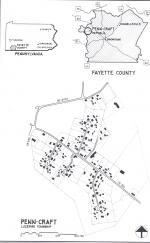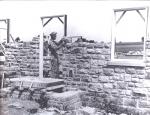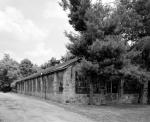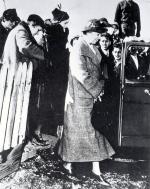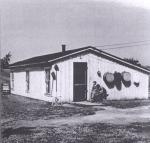![header=[Marker Text] body=[This experimental community for coal miners unemployed during the Depression was developed, 1937-43, by the American Friends Service Committee. On the 200-acre tract, fifty families built their stone houses, a cooperative store, and a knitting factory. A model for other self-help projects elsewhere, Penn-Craft was a successful example of the back-to-the-land movement of the 1930s] sign](http://explorepahistory.com/kora/files/1/10/1-A-2D7-139-ExplorePAHistory-a0k3l9-a_450.jpg)
Mouse over for marker text
Name:
Penn-Craft
Region:
Pittsburgh Region
County:
Fayette
Marker Location:
Township Road 326, Luzerne Township
Dedication Date:
October 8, 1991
Behind the Marker
Although most responses to the Great Depression were government directed, Penn-Craft testifies to the persistence of private, "faith-based" relief initiatives. In the heart of the Great Depression, the  American Friends Service Committee (AFSC), the social services arm of the Society of Friends (Quakers) created Penn-Craft, a planned cooperative community as ambitious as any program sponsored by the federal government.
American Friends Service Committee (AFSC), the social services arm of the Society of Friends (Quakers) created Penn-Craft, a planned cooperative community as ambitious as any program sponsored by the federal government.
During the 1920s, the AFSC had become deeply concerned with the violence that resulted from labor strife, particularly in the bituminous-coal fields of Appalachia. So AFSC volunteers traveled to the bituminous-coal regions in West Virginia and Pennsylvania to help the families of striking and unemployed coal miners.
The AFSC also believed in the necessity of economic and social justice as a means of insuring lasting peace in this section of the United States. To that end, it clothed and fed the families of unemployed miners during strikes, and later launched subsistence gardening and vocational-retraining programs. After the onset of the Great Depression, these experiences placed the AFSC in the forefront of the movement for cooperative communities, so much so that the Department of the Interior, headed by Pennsylvania native Harold Ickes,in 1933 recruited AFSC staff to guide its subsistence homesteads program.
Harold Ickes,in 1933 recruited AFSC staff to guide its subsistence homesteads program.
AFSC executive secretary Clarence Pickett –one of those called upon by Ickes to direct the government's venture in cooperative communities–headed the "Stranded Miners" section within the Division of Subsistence Homesteads for the next three years. Frustrated with the shortcomings of government-directed social reform, he sought private funding for a Friends-sponsored housing initiative.
In the spring of 1936, Pickett pitched his "dream for a new community for coal miners in western Pennsylvania" to executives from U.S. Steel, including an aged J.P. Morgan. The company agreed to give $75,000 to the project, which would be located in a Depression ravaged corner of Fayette County, an area of bituminous coal mines that had once provided the coke that fueled U.S. Steel's mills, and where twenty percent of the population survived on relief.
Fayette County, an area of bituminous coal mines that had once provided the coke that fueled U.S. Steel's mills, and where twenty percent of the population survived on relief.
Pickett hoped that private funding would free the project from the petty politics and governmental red tape that slowed the work in other federally sponsored subsistence homestead projects. He also hoped that the combination of corporate and foundation money (the U.S. Steel grant was supplemented with smaller grants from private foundations) would allow the AFSC to correct a deficiency that had dogged the federally financed communities.
Pickett believed that the government homesteads, in their haste for completion, ignored opportunities to achieve more far reaching social ideals, particularly that of a cooperative economy. Pickett also wanted Penn-Craft to be more responsive to the needs and aspirations of the homesteaders themselves.
With the money secured, the AFSC in 1937 purchased a 200-acre dairy farm northwest of Uniontown and put out a call for applicants. Prospective homesteaders quickly flooded local AFSC offices with applications. To those selected, the AFSC committees awarded plots of land, averaging between 1.5 and three acres, on which to build their homes and cultivate their farmsteads. The Quakers also set aside approximately half of the land for a cooperatively run farm. They named their new community "Penn-Craft," in honor of both William Penn and Isaiah Craft, the property's previous owner.
call for applicants. Prospective homesteaders quickly flooded local AFSC offices with applications. To those selected, the AFSC committees awarded plots of land, averaging between 1.5 and three acres, on which to build their homes and cultivate their farmsteads. The Quakers also set aside approximately half of the land for a cooperatively run farm. They named their new community "Penn-Craft," in honor of both William Penn and Isaiah Craft, the property's previous owner.
In broad outline, Penn-Craft appeared much like Norvelt and other government sponsored cooperatives. But there were important distinctions. At Penn-Craft, the Quakers carefully screened applicants to make certain that they shared the broader Quaker ideals of pacifism and cooperation. Showing a tolerance for personal tastes ignored in federal housing projects, they permitted future homesteaders some input into the look and feel of their homes. And since those structures were made of stone, quarried from nearby deposits, Penn-Craft's buildings had a permanence that distinguished them from the clapboard construction of Norvelt and other government homesteads.
Norvelt and other government homesteads.
Drawing on the Quaker commitment to decision-making by consensus, homesteaders were also encouraged to embrace self-government, which they exercised through participation in monthly meetings of the Community Association (CA), Penn-Craft's governing body. Through the CA's various subcommittees, residents deliberated on everything from education and religion to health care and economic development.
Working with AFSC representatives, the residents decided to start their own sweater factory, which they helped build brick by brick. The factory operated at a loss until it was purchased by an Austrian Jew, who had fled Europe in 1939 to escape Nazi persecution. Under his ownership, the Redstone Knitting Mill managed to turn a profit, and became sufficiently successful to force a move to larger production facilities in nearby Uniontown in 1943.
Although smaller than Department of Interior homesteads–Penn-Craft was one-fifth the size of Norvelt–Penn-Craft in ways proved the more successful of the two ventures. By keeping the community small, its organizers were able to cultivate a spirit of cooperation and fraternity among residents that proved elusive elsewhere. Even as its cooperative ambitions foundered (the cooperative farm ceased to operate during World War II) the community continued to grow.
In 1946, Penn-Craft announced plans to build several new developments. U.S. Steel again supported the project, but the new construction was more loan driven: prospective resident assumed mortgages and were required to place money down in return for community assistance in building houses. When completed, Penn-Craft had added another 100 houses to the original fifty.
Penn-Craft may have succeeded as a housing development, but as a model for American community building, it failed. Although it inspired a handful of scattered cooperative ventures, including a veterans group housing project in Lorain, Ohio, and a "slum clearance" project in Philadelphia, the program itself was never again repeated. After the end of the Great Depression, the farming and industrial cooperatives became privatized, and subsistence farming as a way of life, was abandoned. As soon as coal mines reopened, Penn-Craft residents sought the high wages afforded by unionized industrial workplaces.
During the 1920s, the AFSC had become deeply concerned with the violence that resulted from labor strife, particularly in the bituminous-coal fields of Appalachia. So AFSC volunteers traveled to the bituminous-coal regions in West Virginia and Pennsylvania to help the families of striking and unemployed coal miners.
The AFSC also believed in the necessity of economic and social justice as a means of insuring lasting peace in this section of the United States. To that end, it clothed and fed the families of unemployed miners during strikes, and later launched subsistence gardening and vocational-retraining programs. After the onset of the Great Depression, these experiences placed the AFSC in the forefront of the movement for cooperative communities, so much so that the Department of the Interior, headed by Pennsylvania native
AFSC executive secretary Clarence Pickett –one of those called upon by Ickes to direct the government's venture in cooperative communities–headed the "Stranded Miners" section within the Division of Subsistence Homesteads for the next three years. Frustrated with the shortcomings of government-directed social reform, he sought private funding for a Friends-sponsored housing initiative.
In the spring of 1936, Pickett pitched his "dream for a new community for coal miners in western Pennsylvania" to executives from U.S. Steel, including an aged J.P. Morgan. The company agreed to give $75,000 to the project, which would be located in a Depression ravaged corner of
Pickett hoped that private funding would free the project from the petty politics and governmental red tape that slowed the work in other federally sponsored subsistence homestead projects. He also hoped that the combination of corporate and foundation money (the U.S. Steel grant was supplemented with smaller grants from private foundations) would allow the AFSC to correct a deficiency that had dogged the federally financed communities.
Pickett believed that the government homesteads, in their haste for completion, ignored opportunities to achieve more far reaching social ideals, particularly that of a cooperative economy. Pickett also wanted Penn-Craft to be more responsive to the needs and aspirations of the homesteaders themselves.
With the money secured, the AFSC in 1937 purchased a 200-acre dairy farm northwest of Uniontown and put out a
In broad outline, Penn-Craft appeared much like Norvelt and other government sponsored cooperatives. But there were important distinctions. At Penn-Craft, the Quakers carefully screened applicants to make certain that they shared the broader Quaker ideals of pacifism and cooperation. Showing a tolerance for personal tastes ignored in federal housing projects, they permitted future homesteaders some input into the look and feel of their homes. And since those structures were made of stone, quarried from nearby deposits, Penn-Craft's buildings had a permanence that distinguished them from the clapboard construction of
Drawing on the Quaker commitment to decision-making by consensus, homesteaders were also encouraged to embrace self-government, which they exercised through participation in monthly meetings of the Community Association (CA), Penn-Craft's governing body. Through the CA's various subcommittees, residents deliberated on everything from education and religion to health care and economic development.
Working with AFSC representatives, the residents decided to start their own sweater factory, which they helped build brick by brick. The factory operated at a loss until it was purchased by an Austrian Jew, who had fled Europe in 1939 to escape Nazi persecution. Under his ownership, the Redstone Knitting Mill managed to turn a profit, and became sufficiently successful to force a move to larger production facilities in nearby Uniontown in 1943.
Although smaller than Department of Interior homesteads–Penn-Craft was one-fifth the size of Norvelt–Penn-Craft in ways proved the more successful of the two ventures. By keeping the community small, its organizers were able to cultivate a spirit of cooperation and fraternity among residents that proved elusive elsewhere. Even as its cooperative ambitions foundered (the cooperative farm ceased to operate during World War II) the community continued to grow.
In 1946, Penn-Craft announced plans to build several new developments. U.S. Steel again supported the project, but the new construction was more loan driven: prospective resident assumed mortgages and were required to place money down in return for community assistance in building houses. When completed, Penn-Craft had added another 100 houses to the original fifty.
Penn-Craft may have succeeded as a housing development, but as a model for American community building, it failed. Although it inspired a handful of scattered cooperative ventures, including a veterans group housing project in Lorain, Ohio, and a "slum clearance" project in Philadelphia, the program itself was never again repeated. After the end of the Great Depression, the farming and industrial cooperatives became privatized, and subsistence farming as a way of life, was abandoned. As soon as coal mines reopened, Penn-Craft residents sought the high wages afforded by unionized industrial workplaces.
Beyond the Marker




